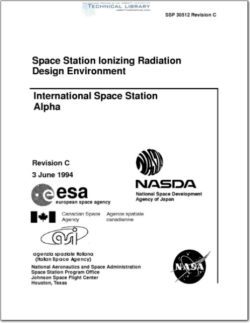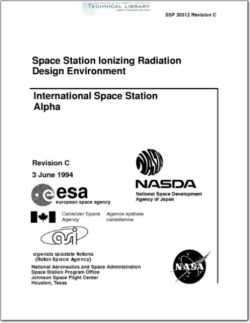NASA-SSP30512RC

- Version
- 189 Downloads
- 337.44 KB File Size
- 1 File Count
- May 18, 2016 Create Date
- May 18, 2016 Last Updated
Space Station Ionizing Radiation Design Environment

The ionizing radiation environment results from the natural radiation in low earth orbit due to
trapped electrons, trapped protons, and solar, anomalous, and galactic cosmic rays. The
contribution of other low earth orbit environmental constituents such as neutrons and x—rays are
negligible and are not included in establishing the ionizing radiation design environment. The
ionizing radiation environment interacts with devices and materials to produce radiation dose
effects and single event effects (SEE).
Dose effects are ionizing radiation—induced changes in devices and materials resulting from
exposure to the trapped proton and electron environment during the orbital lifetime. Dose
effects are usually manifested as degradation of electronic device and material performance and
are cumulative with exposure to the ionizing radiation environment. The ionizing radiation
design environment for dose effects consists of trapped electrons and trapped protons.
The ionizing radiation trapped proton and electron environment for dose effects is determined by
using an orbital altitude for radiation exposure of 500 kilometers, an orbital inclination of 51.6
degrees, the particle flux/solar activity environments as described by AE8MAX for trapped
electrons and AP8MAX for trapped protons, the Epoch 1970 geomagnetic field, and the
equipment on—orbit design lifetime.
The radiation dose in electronic devices and surface coatings is a function of the material in
which the dose is absorbed and the shielding between the electron/proton environment and the
device or material. Doses in silicon at the center of an aluminum sphere, representative of doses
to electronic devices shielded by an equivalent thickness of aluminum, are given in Table
3.1.271. These doses are based on the above electron and proton environments and are given for
a range of aluminum shield thicknesses. The dose resulting from protons and electrons
(including electron—induced bremsstrahlung) are indicated. Table 3.1.2—2 gives similar data for
the dose in silicon detectors at various depths in aluminum semi—infinite slabs, representative of
doses to surface materials.
| File | Action |
|---|---|
| NASA-SSP30512RC Space Station Ionizing Radiation Design Environment.pdf | Download |

Comment On This Post